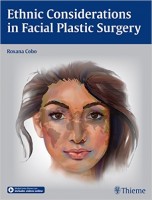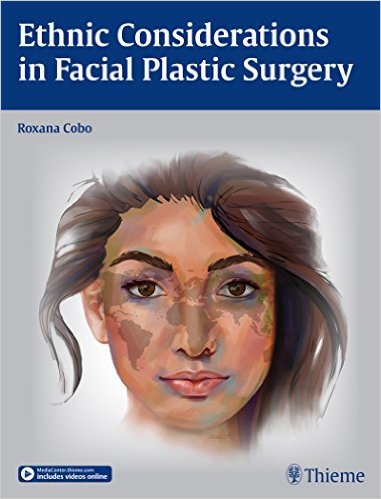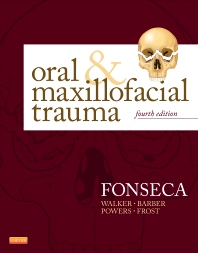 Editor: Roxana Cobo, MD
Editor: Roxana Cobo, MD
Publisher: Thieme – 384 pages, with 1.083 illustrations
Book Review by: Hiro Motiram
What is it about facial plastic surgery on members of different ethnic or multiethnic populations than facial plastic surgery in general? Why the need for this book?
There are several reasons why this book was developed, and some of them are:
- Definitions of beauty vary among different ethnic groups
- Facial features differ a lot. Some groups for example, have flat noses; others have ‘ski slope’ noses. Still others have bulbous noses with lots of flesh. Many desire sculpting.
- Needs and demands for different types of procedures have a broad range worldwide
- Available expertise and skills can be plentiful in some places; scarce in others
The editor, Dr. Roxana Cobo, a professor and practitioner of facial plastic surgery, points out that there are books on specific topics in facial surgery, or on special techniques in this field, “but to date, we do not have a comprehensive source focusing on the many considerations that should be taken into account when dealing with patients of multiethnic backgrounds. This book was written to address that dearth of information.” So the work commenced to fill this need.
Fifty-six people, who are mainly physicians and surgeons that teach and practice facial plastic surgery and related subjects, from 17 countries around the world – Brazil, China, Colombia, Egypt, Hong Kong, Italy, Mexico, the Netherlands, Philippines, Saudi Arabia, Singapore, South Korea, Spain, Thailand, Turkey, the United Kingdom, and the United States – wrote the 32 chapters of book that are organized around six sections.
Four of the six sections (sections II to IV) deal with facial plastic surgery on patients with different ethnic complexions and features; the first section on general considerations, and the last section on special topics. To give you a brief overview, we name below the titles of the six sections of this book:
- Section I – General Considerations
- Section II – The Latin American / Mestizo Perspective
- Section III – The African Perspective
- Section IV – The Asian Perspective
- Section V – The Mediterranean and Middle Eastern Perspective
- Section VI – Special Topics
Procedural Videos: In addition to the information in the six sections named above and the 1,083 full-color and black-and-white illustrations within the 384 pages of this book, you the buyer of this book can also view 31 videos of plastic surgery procedures as part of your overall learning and training process. Here is what to do:
- Visit www.MediaCenter.Thieme.com
- Read the requirements on the inside front cover of this book for Windows, Mac and Tablet, pertaining to:
- Recommended browser
- Flash Player Plug-In
- Minimum Hardware Configurations
- Recommendations for optimal usage experience
- When prompted during the registration process, simply enter the code found on the inside front cover of this book
- View the 31 videos of various facial plastic surgeries
Each of the four ethnic-related sections of this book begins with a chapter where aesthetic, cultural, and ethnic considerations of each group are laid out and dealt with, and current trends discussed. With plastic surgeons writing from 17 countries worldwide, it is enlightening to learn about the different procedures their patients seek and receive.
An interesting part of this book to look at, for readers of BIZ INDIA Online News, is chapter 17, Aesthetic, Ethnic, and Cultural Considerations and Current Cosmetic Trends on the Asian Population as part of Section IV, The Asian Population.
The authors of this chapter – Gordon M.S. Soo, Choladhis Sinrachtanant, and Frederick T.C. Wong – write in their Introduction that Asian facial features vary considerably as one moves across the Asian continent from east to west and down from north to south, but there are “a few generalizations and rules that permit a discussion of the aesthetics of the Asian facial profile.” They then point out to three distinctly different ethnic types within the Asian population:
- Asian-Oriental (Mongoloid) – people of China, Korean Peninsula, Japan, and Taiwan
- Asian-Malay – inhabitants of Borneo, Indonesia, Laos, Malaysia, Myanmar, the Philippines, Singapore, Thailand, and Vietnam.
- Asian-Caucasian – residents of the Indian subcontinent (India, Bangladesh, Pakistan, Sri Lanka), middle Asia, northern Asia to Russia, and western Asia to Turkey.
In their Conclusion, the chapter’s authors point out that the surgical cosmetic industry is increasing ‘exponentially’ as a result of growing economies in that region of the world, and it is ‘booming’ in some countries there. A few of the popular facial surgical procedures for Asians are augmentation of the nose, and in eyelid surgery, the creation of the double lid and epicanthoplasty.
There are probably few if any, books available on facial plastic surgery with an ethnic approach. So this is a rare one – and a good one to boot, with access to 31 valuable videos.
Editor:
Roxana Cobo, MD is Head of the Department of Otolaryngology at Centro Medico Imbanaco in Cali, Colombia. She is Ad-Honorem Professor of Facial Plastic Surgery in the Department of Otolaryngology at Nueva Granada Military Hospital, and Nueva Granada Military University in Bogota, Columbia.







